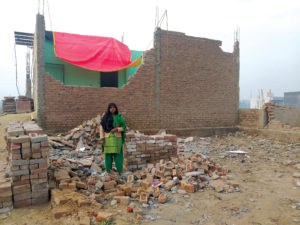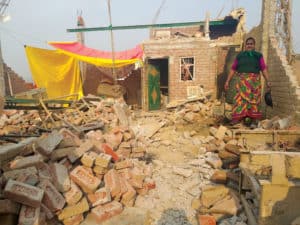The hailstorm created snow-like vistas in Noida but brought disaster to a village in Greater Noida — in a matter of seconds
“There was a sudden bolt of lightning and something that looked like a ball of fire. It sounded as if an aeroplane or a helicopter was landing. We lost everything in the blink of an eye.” This is how a resident of Alivardipur (Gautam Budh Nagar) describes the wrath of Nature they witnessed on February 7.
The descriptions are vivid. “The noise was really loud, it was terrible,” says another. “It felt like we would suffocate. Our house began shaking and in just a few seconds, it collapsed. The wind was so strong that it could have carried people away. It was like a whirlwind that destroyed everything that came its way.”
When Delhi-NCR was posting pictures of the hailstorm that made roads look like a snow-laden landscape of a hill station, complete mayhem broke out in a village. Strong gusts of wind, like a cyclone, deprived hundreds of people of the roof over their heads. As many as 200 houses collapsed, leaving more than 40 people severely injured.
The storm rendered over 1,000 people homeless as their pucca houses were destroyed within seconds. Many residents were crushed under piles of bricks, such was the intensity of the gale that lashed the village.
“It was just a matter of 15 seconds. Poles fell, entire houses fell — everything was destroyed,” relates 46-year-old Jamaal. “People were stuck under the debris for a long time. We are all labourers. We have come here from Bengal, Bihar and different cities in search of a livelihood. No ministers have visited us here. No relief measures were carried out for us. Even when visitors come, they just see the first few houses. No one bothers to come to the interior areas of the village to understand the extent of the destruction.”

A mud track leads to the village, where a glimpse is enough to envisage the might of the storm that has shaken up the residents and left the area in ruins. Concrete debris and broken bricks dot the village. A few houses are left with remains of two or three walls and no roof, doors were blown away by the powerful wind, steel rods are contorted, injured men and women are lying on cots outside their broken houses.
The residents complain that they have not been provided any assistance. A few villagers are preparing the cement mixture to rebuild their houses — the destruction that was caused, along with the exasperation of the villagers, is conspicuous.
Shahjahan Ali, 35, says, “No one exactly knows what is was. At around 7:15 in the evening, there was an extremely loud noise and everything was destroyed within seconds. It was like a powerful swirling wind that wreaked havoc on our houses. It took away even our bed and cupboard.”
Days have gone by as they wait in vain for financial aid and relief measures by the government. Fatima Sheikh, a 47-year-old woman with stitches on her head and a fractured leg says, “My son and daughter-in-law are still hospitalised. Their condition is really critical. We have a two-storey house, the second storey was completely blown away and the ground floor was also razed to the ground. We have not got any kind of help from anyone. Ministers and authorities did not even bother to visit the area, let alone provide any aid. We will have to build our lives from scratch now.”

Most of the villagers are daily wage labourers, who were already living in poverty, struggling to make ends meet. Now they have lost their houses and most of their belongings, which has left them in distress. Shabnam, a 23-year-old who is pregnant, has got excruciating injuries on her face. Her eye has a blood clot and her cheeks are swollen. She says, “We lost everything in the storm. I was cooking food outside on the chulha when it happened. Those who were inside were not as badly injured as I was. I could not remember anything for two days.”
With an extremely perturbed look on his face, 45-year-old Ravikant Dubey, who is a peon at a school in the village that now stands broken, says, “Come, look at what the storm has done to my house. My wife, who got stuck under the debris, suffered severe injuries and had to get stitches.” He too, sustained injuries on his head.
Irfan, 32, removes the cloth with which he has covered his wounded leg to reveal an infection. He questions, “Please tell me, what should I do now? Where should I go?” His helplessness is evident when he shows the broken bricks and points towards the upper half of his house, which is completely destroyed. They have set up a makeshift kitchen and have covered their houses with plastic sheets.
Farhan Mujeed, 87, lying on his khaat (cot) as he is unable to walk because of his injuries, complains of how no one has reached out to them for help. “Everyone in my family got injured. Both my son and daughter were hospitalised. Now I have sent them to another village where they can get better care. I can’t even explain in words what we are going through. For two days, we could not eat anything. But what can we do now when no one is ready to help us,” he says with a disconcerted look on his face.
“My single-storeyed two-room house was blown away by the winds,” says 32-year-old Mohammed. “Within seconds, bricks began falling on us. A noisy gust of wind blew everything away. So many people were injured and hospitalised, some are still struggling for their lives. Many who were admitted to the hospital have come back now because they could not afford the rising cost of treatment. We are poor, there is no one to pay heed to our misery.”
Khushma complains that no one has been able to go to work since they were hit by the storm. She says that the children also cannot go to school as their books and bags are destroyed. “Some are still undergoing treatment in the hospital, some don’t even have the money to afford treatment. We are getting no compensation from the government as they say that our houses are illegally constructed. But why was registry done if the houses are illegal?” she questions furiously.
The plight of the villagers is indeed piquant. “We have our registry papers and we don’t understand why it is being called illegal.” It seems likely that the papers were prepared by forgery and fraud.
A few houses were left unharmed, in others only a few bricks of the upper storey fell. Anees, 36, was not so fortunate. His entire house collapsed, injuring his spine. He was standing near the gate of his house when the wind pushed him against the wall with heavy force. He was trapped under falling bricks. “People came forward to get him out. He was saved just by God’s grace,” says his wife, Tasleem, adding, “He can no longer walk or talk much.”
Anees then cut in, speaking with difficulty: “It is really painful to talk, which is why I don’t talk much.” Tasleem continues, “He can’t go to work. I can’t leave my kids at home and go to work. So where will we get money from? We will eat if someone gives us food. Otherwise, we will just sit here and wait for death.”
“We went to Safdarjung Hospital. The doctors there said that we will not be able to afford the treatment, so we should go home. We are dying a little every day. But we can’t do much. Now it all depends on Allah’s grace,” she adds.
Mohsin, 47, says, “Gareeb aadmi ki sunwaayi nahin hai kahin bhi (Nobody listens to poor people anywhere). There are six people in our family, all got hurt. We are not educated but you tell us, you can see the condition of the houses, what do you think would have been the condition of people who were inside the house?” Nirwan, 50, whose wife and children are all injured, claims that a minister came and said that it is a Muslim area so, “No need to help them.”
“When they come to ask for votes, they join hands in front of us,” adds Nirwan. “Where are they now when we need help? How much money can we arrange for treatment? Let us die here, if illegality can be used as a ground for not providing any assistance or kindness to people in need.”





